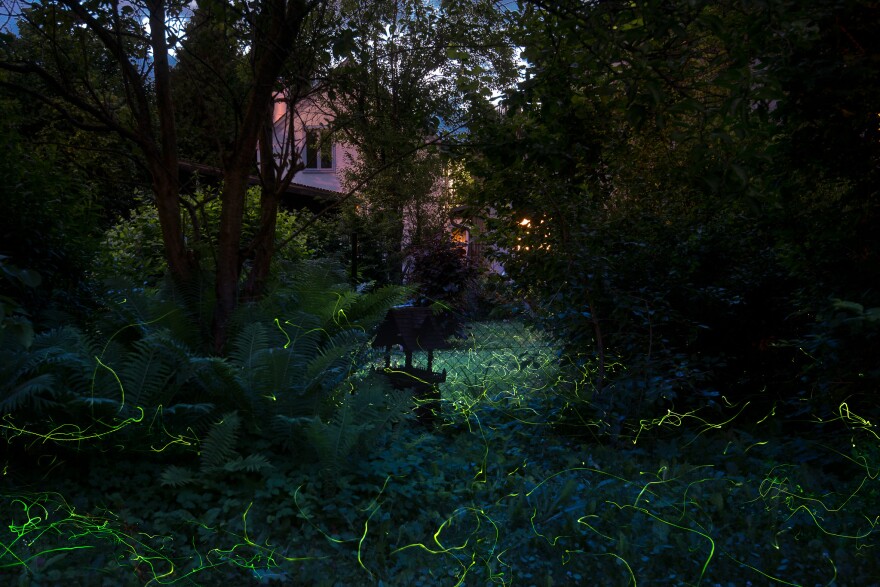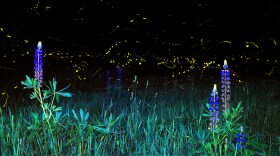This story was originally produced by the Monadnock Ledger-Transcript. NHPR is republishing it in partnership with the Granite State News Collaborative.
A swath of Granite Staters saw their backyards lit up this summer. Not from streetlamps and not from their porch lights, but from small, electric bugs that experienced a resurgence in the region this season.
Fireflies appeared more across the state and in New England because of a variety of ideal weather conditions — but a lapse in tracking of these lightning bugs has caused gaps in truly understanding their history and how they can thrive.
“We’re doing everything that we know is important to keep those populations that we find and that people are enjoying active and glowing for many years,” said Christopher Cratsley, a professor of biology at Fitchburg State University in Massachusetts.
-
Here’s why the third wettest spring on record in New Hampshire has made for a firefly renaissance this summer.
What is a firefly?
Fireflies are a part of a family of beetles with around 200 different species in North America alone, Cratsley said. They start in a larval state, buried under soil and leaf piles for up to a year, growing and molting several times throughout the process.
The glow, Cratsley said, can be stimulated by touch or vibrations from the ground but is also helpful to keep itself safe in its vulnerable state.
“We think that the glow is sort of like the bright colors on a poisonous snake, a warning sign to potential predators to stay away,” Cratsley said. The chemicals that make it shine are unpleasant and toxic to predators.
In adulthood, some fireflies flash, some glow and others don’t shine at all. For the ones that do, it is caused by interactions with oxygen, “cellular energy” adenosine triphosphate or ATP, and an enzyme called luciferase that causes bioluminescence, Crastley said.
Adults typically live for two months, just enough time to attract mates and lay eggs.
More fireflies around New England
Richard Joyce, an endangered species conservation biologist at the Xerces Society, attributed the abundance of fireflies this season to a wet spring, creating an ideal damp environment for larvae survival.
On top of that, the northeast experienced a wetter-than-average fall two years ago, which was critical for freshly born larvae to develop, Joyce said.
Last fall was drier than average, but Joyce said an abundance of fireflies likely reached a large enough stage to make it to adulthood.
“I think that at this point, most of the fireflies had gotten big enough that they were a little more resilient, and they could just hunker down and maybe find some damper places,” he said.
Joyce said no reliable data exists on how many fireflies appear each year in New Hampshire or if there is a trend of growth or decline. Of the 14 species that live in the state, none are endangered, he added.
Troubles with firefly tracking
Joyce is a part of a project called Firefly Atlas — a collaborative project to better understand and protect fireflies across the U.S. and Canada.
The project relies on observations and recording, which is then tracked on their map. Joyce said a “big lack of data” prevents tracking how many fireflies appear each year and which species are most prevalent.
“We’re at a point with community science with, say birds, where there are so many people out there bird watching and jotting down lists of birds that they see … that we really have this very fine resolution picture of how birds are doing and where they’re found in the United States,” Joyce said. “We’re very far from having that for fireflies.”
Drought and habitat loss are the leading threats to firefly populations, Cratsley said.
“When they’re in the soil, they do not have a way to flee and disperse very quickly,” Cratsley said. “If that soil location is turned into a foundation for a building or turned into a parking lot, then they don’t have a way to occupy a different habitat.”
How can residents help build firefly habitat?
Fireflies and other insects gravitate toward a variety of different plant and tree species, especially if they are native, said Matt Tarr, the state wildlife habitat specialist for the University of New Hampshire Cooperative Extension.
“There is no one-size-fits-all all,” Tarr said. “So landscapes that have a variety of those different types of plants in close proximity are more likely to support an abundant diversity of insects than a landscape that only has fewer types of plant species.”
While more is better, Tarr said not everyone has large pieces of land that can support that much plant diversity. However, having different plants than your neighbors can also cultivate the growth of insects and other wildlife.
“If I can provide something on my land that doesn’t occur on my neighbor’s land, that gives wildlife species and insects a reason to come to my land, but it also enhances the habitat diversity and options within my neighborhood,” Tarr said.
For fireflies specifically, Joyce recommended keeping grass and wildflowers tall to promote moisture and avoiding pesticide use to keep the bugs alive.
While the summertime is prime time for fireflies, Joyce said the fall, especially September, can be a great time to view them as well.
“We’re kind of at the end of the season for flashing fireflies, but if you pay attention, you can make firefly watching almost a year-round activity,” Joyce said. “You go out after it’s rained, on a night when it’s not too cold, and you’ll find all these glowing dots of light in the yard, which is a pretty cool thing to see.”
These articles are being shared by partners in the Granite State News Collaborative. For more information, visit collaborativenh.org.



